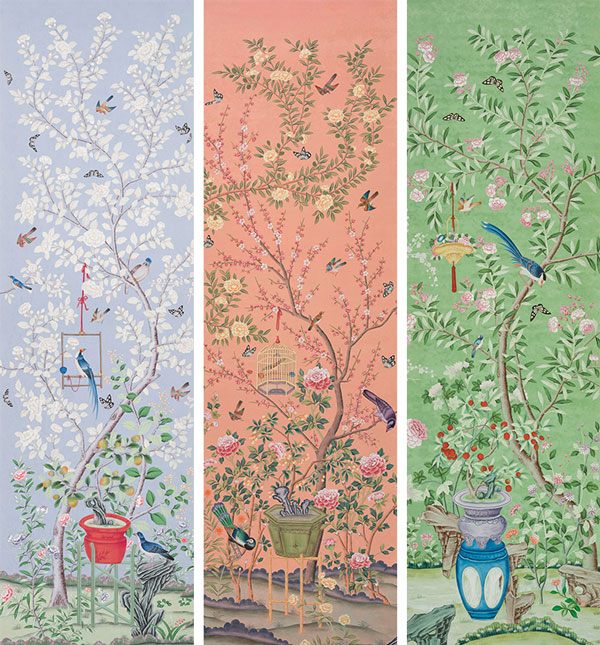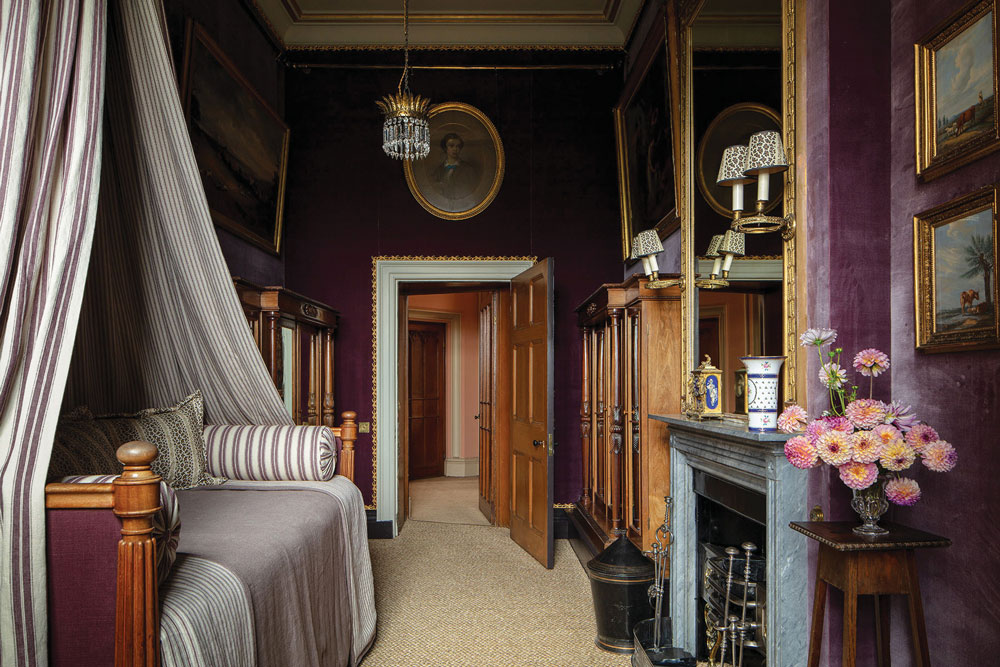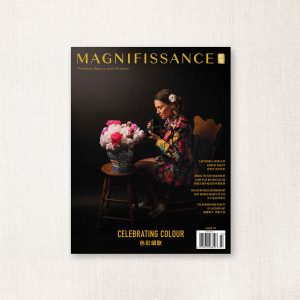
De Gournay Wallpaper Revives Fairy-Tale Belvoir Castle
In the heart of the English countryside, de Gournay revives a historic castle with traditional hand-painted wallpapers.
- Text by Charlotte McManus
- Photography by Dylan Thomas
“Within our own homes, you and I might say that 10 years is a long horizon for the decoration of a room. But at Belvoir, they’re looking for the decoration to stand up to another two centuries.”
—Dominic Evans-Freke
“One of my greatest pleasures is keeping traditions alive. Some things of the past are very much worth preserving,” says Dominic Evans-Freke, director of de Gournay, a British company specializing in hand-painted and hand-embroidered wallcoverings.
De Gournay was recently commissioned to bring new life into England’s Belvoir Castle with a sumptuous interior renovation. By introducing a historically infused design scheme to the newly named Howard Room, Evans-Freke and his team hoped to revive the space with lasting appeal, marking a new chapter within the ever-evolving narrative of the castle.

With an august history that began in the 11th century, Belvoir (pronounced ‘beaver’) is one of the nation’s most impressive examples of Regency architecture. Positioned on top of a hill in the Vale of Belvoir, Leicestershire, the stately home’s classic good looks are recognizable from films such as The Da Vinci Code and TV series such as The Crown.
Belvoir has served as the ancestral seat of a single dukedom for almost 1,000 years—a rare feat, even by English lineage standards. Today, the castle is home to the current Duke and Duchess of Rutland, David and Emma Manners, and their five children.
Not your typical homeowners, the Duke and Duchess are the latest iteration in an unbroken line of stewards, each caring for Belvoir in their lifetime before passing on the mantle.
“These ‘treasure houses’ are part of the historic fabric of the nation, woven into the story of England,” Evans-Freke says. “Within our own homes, you and I might say that 10 years is a long horizon for the decoration of a room. But at Belvoir, they’re looking for the decoration to stand up to another two centuries.”
Evans-Freke likens the nature of heritage house stewardship to that of possessing a Patek Philippe watch—one never truly owns the object in question, but instead looks after it for the next generation. “You’re only the custodian,” he says.

Eastern promise
Belvoir Castle houses a prized collection of antique Chinese wallpapers, many of which date back to the 1700s. A jewel in this crown is the paper hung in the Wellington Room—the space is named after the Duke of Wellington who stayed there in the 1850s. That scene depicts an ornate Chinese garden, with peonies and exotic birds rendered in delicate pistachio and vivid berry hues.
A by-product of the flourishing trade that took place between China and Europe in the 18th century, this type of wallpaper combined artistic elements from both East and West and was typically used to express the height of cultural sophistication in palaces and stately homes.
When the opportunity arose to recreate the Wellington Room wallpaper, de Gournay was a natural choice for the task. Not only is the family-run English company a distinguished maker of hand-painted wallpapers—including traditional Chinoiserie—but its craftspeople are also experts in the same time-honoured artistry that shaped the Wellington Room’s original design.
“In Chinoiserie you have to work with two brushes. You have to put the colour on with one; you have to move with water with the other. If you don’t do that, you don’t create something that looks like the original. It’s not authentic,” Evans-Freke says.
“We’re using traditional forms of Chinese painting. This is what people learned in school on their teacher’s knee in the past.”
The production of De Gournay’s wallpaper involves time-consuming procedures of layering in which different artists bring their unique expertise to the finished product. “It’s layers of skill. It’s layers of physical paint. In some cases, it’s slightly different mediums, slightly different materials, and it all adds up to a much more lively product than we could get in any modern reproduction method,” Evans-Freke says.

Grand designs
The second portion of the Belvoir Castle project was even more ambitious. The Duke and Duchess decided to renovate one of the state bedrooms, the Brown Room—now redubbed the Howard Room—with de Gournay’s wallpaper placed in situ.
This transformation was no simple feat, requiring due deference to the room’s heritage and scale. To do the task justice, the company worked in collaboration with traditional interior decorating firm Sibyl Colefax and John
Fowler, as well as with a plethora of homegrown artisans.
Evans-Freke and his team spent countless hours immersed in Belvoir Castle’s extensive archive. There, they discovered a striking colour scheme for the Brown Room that had been once envisioned but never realized. Using this as inspiration, the new wallpaper was themed around a palette of apricot and blue.

Reflecting on the process, Evans-Freke says, “David and Emma have such a strong sense of ownership—not just for themselves, but also for future generations. Every conversation came back to, ‘Do we think it’s appropriate? Will we like it in 50 years?’”
The finished space is undeniably grand. Clad in rich upholstery, gleaming gilt, and pink-and-blue Chinoiserie wallpaper, the bedroom feels warmly welcoming despite its luxury. Meanwhile, the antechamber has been updated into an elegant dressing room. The silk velvet-upholstered walls by de Gourany are in the same deep amethyst as the seed pods from the bedroom wallpaper, adding a touch of aesthetic harmony.
“The level of depth in the papers is absolutely evident, especially in the juxtaposition,” Evans-Freke says. “The juxtaposition of the layers on the paper, of the paper against the furnishings, of the fabrics—that layering is so exquisitely intentional yet, at first glance, seamless.”
A living showcase of traditional craftsmanship, the revived Howard Room exudes brightness and charm while upholding the aura of its past. And yet, for all the project’s success, de Gournay’s director contemplates the inextricably transient nature of the new interiors.
“The beautiful things that we’ve created will not be beautiful forever—they’re ephemeral, they’ll get damaged, they’ll get older. But that’s part of their beauty,” Evans-Freke says. “Living in these interiors, giving them texture through real life, is part of the piquancy that makes them beautiful.”
Inspired for a Beautiful Life
Related Articles

Travel With the Perfumer Jacques Cavallier-Belletrud
Jacques Cavallier-Belletrud pays homage to Louis Vuitton’s first fragrance with his new 2020 scent.

Discover Goddess Within
Eden Zhu grew up in China but only after coming to the United States did she grasp the deeper meanings hidden within Chinese culture.

The Maître Tea of Paris
Authentic Chinese tea culture has almost been lost to modern times, but the tea master at La Maison du Trois Thés in Paris continues the tradition.











